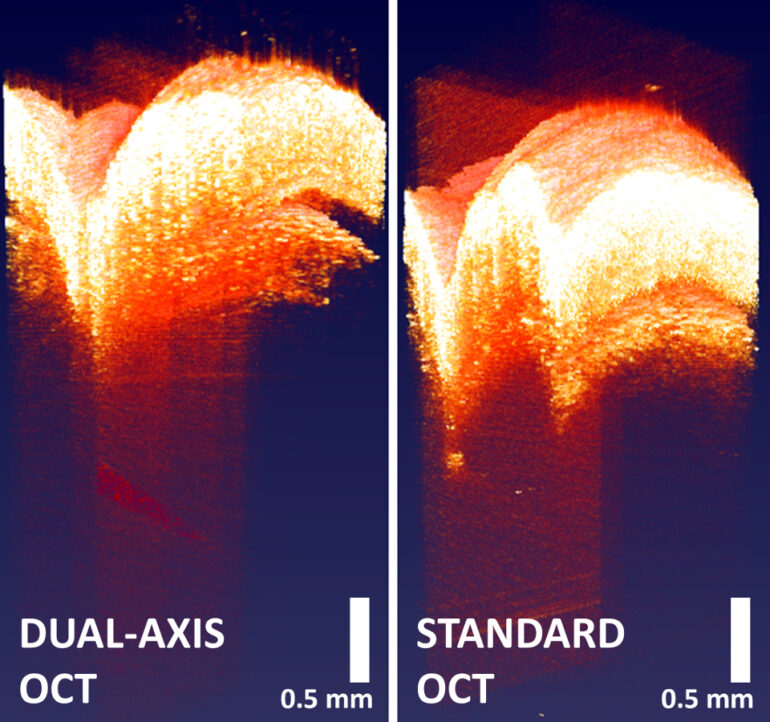Biomedical engineers at Duke University have demonstrated a method for increasing the depth at which optical coherence tomography (OCT) can image structures beneath skin.
The gold standard for imaging and diagnosing diseases within the retina, OCT has yet to find widespread use as an imaging technique for other parts of the body due to its inability to return clear images from more than a millimeter beneath the skin’s surface.
Duke researchers found that tilting the light source and detector used in the technique increases OCT’s imaging depth by almost 50%, putting skin diagnoses within reach. The “dual-axis” approach opens new possibilities for OCT to be used in applications such as spotting skin cancer, assessing burn damage and healing progress, and guiding surgical procedures.
The results appear online on December 1 in the open access journal Biomedical Optics Express.
“It’s actually a fairly simple technique that sounds like something out of Ghostbusters—you get more power when you cross the beams,” said Adam Wax, professor of biomedical engineering at Duke. “Being able to use OCT even 2 or 3 millimeters into the skin is extremely useful because there are a lot of biological processes happening at that depth that can be indicative of diseases like skin cancer.”
Standard OCT is analogous to ultrasound but uses light instead of sound. A beam of light is shined down into an object, and by measuring how long it takes for it to bounce back, computers can deduce what the internal structure of the object looks like. It has become the go-to technology for imaging and diagnosing retinal diseases because the retina is so thin and easily accessible through the eye’s transparent cornea and lens.
Most other biological tissues, however, scatter and reflect light, making it difficult to penetrate with standard OCT approaches. The deeper the light goes, the more likely it is to get lost in the sample and miss the device’s detection.
In the new technique, researchers instead point the light at the object at a slight angle and set up the detector at an equal and opposite angle, creating a dual-axis. This allows the detector to benefit from the slight scattering angle introduced by the object’s physical nature.
“By tilting the light source and detector, you increase your chances of collecting more of the light that’s scattering off at odd angles from a tissue’s depths,” said Evan Jelly, a doctoral student in Wax’s laboratory and first author of the paper. “And OCT is so sensitive that just a little bit more of that scattered light is all you need.”
According to Jelly, researchers have tried this dual-axis approach in other imaging modalities. But through his experiments, Jelly discovered how to apply this to OCT. His key discovery was that the depth of the focal point of light within the tissue makes a large difference in how well the dual-axis approach works.
However, there is a catch: The greater the angle used to identify deeper signal, the smaller the field of view becomes. To get around this issue, Jelly devised a method of scanning the focus of the narrower window through various depths of the tissue and then using a computational algorithm to combine the data into a single image.
In the paper, Wax and Jelly tested this approach with fabricated tissues and hairless mice to benchmark its performance against standard OCT to see what information it could reveal in a live animal’s skin. The controlled experiments showed that the dual-axis OCT approach does tend to outperform the standard setup. And in the live mice, the dual-axis OCT was able to image the tip of a needle 2 millimeters beneath the skin’s surface, where 1.2 millimeters is traditionally the landmark depth.
“The dual-axis OCT gave us images and information from the layers of skin where blood and molecular exchanges are occurring, which is extremely valuable for detecting signs of diseases,” said Jelly. “The technology is still in its infancy, but it is primed to be highly successful for biosensing or guiding surgical procedures.”
More information:
Evan T. Jelly et al, Deep imaging with 13 µm dual-axis optical coherence tomography and an enhanced depth of focus, Biomedical Optics Express (2021). DOI: 10.1364/BOE.438621
Citation:
Eye imaging technology breaks through skin by crossing beams (2021, December 1)



